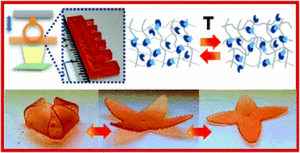Rossegger et al. present a new transesterification catalyst which can be applied in thiol-acrylate vitrimer systems enabling the fabrication of precise 3D objects.
Vitrimers are a unique class of materials that possess the remarkable property to be thermally processed in a liquid state while maintaining their network integrity. This property is induced owing to various thermo-activated exchange reactions including the catalyzed transesterification of hydroxyl ester moieties. However, the possibility to introduce dynamic covalent bonds into 3D printable photopolymers is challenging and the printed objects often suffer from a range of limitations such as low resolution, poor surface quality and lack of versatility. In addition, conventional transesterification catalysts exhibit poor solubility and present additional compromises on cure rate and pot life of photocurable resins. To this end, Schlögl and co-workers introduced a mono-functional oligomeric methacrylate phosphate as a new and efficient transesterification catalyst. The catalyst has many advantageous characteristics: it is liquid, easily dissolved in a range of acrylic monomers and can be covalently incorporated into the network across its methacrylate group. Once photo-cured, the dynamic thiol-click networks are able to rapidly undergo thermo-activated rearrangements of their network topology as shown by stress relaxation experiments. Importantly, when applied in thiol-acrylate vitrimer systems, precise 3D objects with 500 µm features using bottom-up digital light processing can be obtained. When compared to other commonly employed catalysts, the mono-functional methacrylate phosphate is superior both in terms of solubility and stress relaxation, thus unlocking a new toolbox of photocurable vitrimers.
Tips/comments directly from the authors:
- Owing to their strong Brønsted acidity, organic phosphates are able to catalyze transesterifications in hydroxyl ester networks. They exhibit a better performance in catalyzing exchange reactions in dynamic photopolymers compared to Lewis acids such as Zn(OAc)2.
- Stress relaxation kinetics increase with rising catalyst content. However, the catalyst content should not exceed 50 mol% as the resin formulation is getting destabilized. Below 50 mol%, the thiol-click resin is stable over several weeks. This is a clear advantage compared to conventional transesterification catalysts, which initiate thiol-Michael reactions and lead to a premature gelation of thiol-click resins.
- Prior to the shape memory experiments it is important to thermally anneal the networks to form additional crosslink sites by hydrogen bonding, which lead to a change in thermal and mechanical properties. After 4 h at 180 °C, the network properties remain constant and the printed test specimen are able to repeatedly undergo shape changes after the programming step.
- Organic phosphates are highly versatile transesterification catalysts and can be applied for imparting dynamic network properties in numerous photopolymer systems. Network architecture can be conveniently adjusted by the structure and functionality of the monomers and/or crosslinkers.
Citation to the paper: Digital light processing 3D printing with thiol–acrylate vitrimers, Polym. Chem., 2021,12, 639-644, DOI: 10.1039/D0PY01520B
Link to the paper:
https://pubs.rsc.org/en/content/articlepdf/2021/py/d0py01520b
 Dr. Athina Anastasaki is an Editorial Board Member and a Web Writer for Polymer Chemistry. Since January 2019, she joined the Materials Department of ETH Zurich as an Assistant Professor to establish her independent research group.
Dr. Athina Anastasaki is an Editorial Board Member and a Web Writer for Polymer Chemistry. Since January 2019, she joined the Materials Department of ETH Zurich as an Assistant Professor to establish her independent research group.











